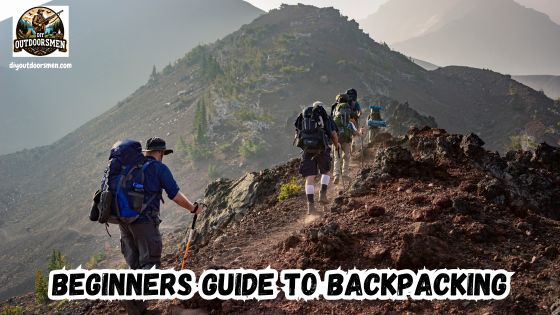Contents
- 1 Essential Gear for Beginner Backpackers
- 2 Getting Started with Backpacking
- 3 Quick Guide to Planning Your Backpacking Trip
- 4 Key Considerations Before Hitting the Trail
- 5 Advanced Tips and Tricks for Backpacking
- 6 The Basics: Choosing the Right Equipment
- 7 Environmental and Social Impact of Backpacking
- 8 Frequently Asked Questions on Backpacking for Beginners
- 9 Wrapping Up Backpacking for Beginners
Backpacking offers an accessible way to enjoy nature, explore different landscapes, and experience adventure without the need for sophisticated planning or expensive equipment. I have found that a mix of careful preparation and flexibility can make even a first-time backpack trip a rewarding experience.
QUICK LOOK:
- Select the Proper Gear: A properly fitted backpack evenly distributes the load, reducing the risk of injury during long hikes. A quality tent and sleeping bag, and packable cooking gear.
- Choose Your Hike: It is wise to look into the history of the trail and to talk to local experts if possible. These sources can provide insights that might not be available online or in guidebooks. Begin by confirming the trail conditions.
- Check for any recent weather changes or advisories that might affect the area. I make it a habit to review local park websites and outdoor community boards for recent reports by other hikers. Gathering this information helps you prepare for any challenges that might arise during the trip. Consider planning contingency routes. Sometimes, a sudden change in weather or unexpected trail closures might force you to deviate from your planned path
- Develop an itinerary that outlines your intended stops and rest points along the way. I find it helpful to set realistic daily goals, taking into account both distance and elevation changes. Always inform someone you trust about your travel plans and your expected return time.
- Organizing your meals and water supplies in advance can also reduce stress as you traverse challenging terrains. Experiment with your portable stove and cooking setup to see what works best when outdoor conditions vary. This preparation minimizes time spent fumbling with equipment and maximizes your opportunity to enjoy the scenery.
- Practice with Your Gear: Practice setting up your tent in a variety of weather conditions so that you become intimately familiar with its mechanisms. Practice loading and walking with your backpack at home.
- Refining your navigation skills can also improve your pace and safety over longer journeys. I practice combining modern digital tools with traditional methods to ensure accuracy, even when unexpected obstacles arise. Testing these skills on different types of trails boosts your confidence and helps you feel more secure in unfamiliar territory.
- Experimenting with meal planning and cooking in the outdoors can add a fun twist to your trips. Trying out recipes that require only a few ingredients and are simple to prepare in nature can enrich your experience. Such culinary experiments not only supply essential energy but also turn everyday meals into memorable moments on the trail.
- Always keep track of your physical stamina with regular practice hikes. Gradual endurance training improves your overall fitness and builds confidence to tackle longer, more challenging treks. Monitoring your progress ensures that each journey is both enjoyable and safely within your limits.
This guide provides straightforward advice and clear steps for beginners to help ensure that your backpacking trips are safe and enjoyable.
Essential Gear for Beginner Backpackers
When starting on your first backpacking trip, choosing the right gear can greatly influence your experience. I recommend beginning with a simple setup. A comfortable backpack is the centerpiece, with compartments designed to help you organize your supplies efficiently.
Consider a lightweight tent and a sleeping bag that suits the weather conditions of your destination. I also advise checking out portable cooking equipment, such as a small stove, to prepare meals on the trail.
Other essential items include weather-appropriate clothing, a first aid kit, and a reliable water filter or purification tablets. Every piece of equipment plays a very important role, especially when you are venturing into areas with unpredictable conditions.
Understanding exactly what you need before you head out can prevent last-minute scrambles and help you pack more effectively. In addition, it is beneficial to invest time in testing your gear at home. Spending some time with each item allows you to be familiar with its functionality, which can prove invaluable once you are out in the wilderness.
Furthermore, considering the durability and multi-use nature of many backpacking supplies can seriously cut down on the number of items you need to bring. For example, a bandana might serve not only as a handy accessory but also as a makeshift towel, a head cover, or even as a tool for filtering water.
This approach not only lightens your load but also boosts your confidence in handling unexpected situations during your trip.
Getting Started with Backpacking
Beginning backpacking requires a solid foundation in basic travel planning and an awareness of outdoor safety. I have learned that the best backpacking experiences start with clear, detailed planning.
Mapping out your route, understanding the local terrain, and being aware of the weather forecast are all important steps to take before you leave home. Preparing in advance allows you to feel more secure and less rushed once you set out.
It is also useful to spend some time researching the culture and natural environment of the area you intend to explore. This research can help you decide on the duration of your trip, the difficulty of the trails, and any permits or regulations that may be necessary.
If you are new to backpacking, starting with a short day hike before committing to an overnight trip can build your confidence and introduce you to the basics of outdoor navigation and trail etiquette. The experience you gain from such shorter trips is invaluable, as it prepares you for longer, more challenging adventures ahead.
Quick Guide to Planning Your Backpacking Trip
Effective planning is vital to a successful backpacking adventure. I suggest beginning by selecting a destination that matches your current experience level. Once you have chosen a trail, the next steps involve a practical approach to organizing your trip.
- It is wise to look into the history of the trail and to talk to local experts if possible. These sources can provide insights that might not be available online or in guidebooks. Begin by confirming the trail conditions.
- Check for any recent weather changes or advisories that might affect the area. I make it a habit to review local park websites and outdoor community boards for recent reports by other hikers. Gathering this information helps you prepare for any challenges that might arise during the trip.
- Develop an itinerary that outlines your intended stops and rest points along the way. I find it helpful to set realistic daily goals, taking into account both distance and elevation changes.
- Organizing your meals and water supplies in advance can also reduce stress as you traverse challenging terrains.
- Always inform someone you trust about your travel plans and your expected return time. Taking these extra steps ensures that, in case of emergencies, someone is aware of your whereabouts and can alert rescue services promptly.
- Additionally, consider planning contingency routes. Sometimes, a sudden change in weather or unexpected trail closures might force you to deviate from your planned path. Having alternate routes mapped out in advance can save time and reduce the anxiety of making decisions under pressure.
Key Considerations Before Hitting the Trail
Before setting out, there are several factors to consider to help ensure your trip goes as planned. It is very important to be aware of the challenges that might impact your backpacking experience. I have encountered several common issues that are worth noting for new backpackers, and preparing for them can make a big difference in your overall enjoyment.
- Weight and Packing: Carrying too much weight or distributing the load unevenly can lead to discomfort and fatigue. I recommend spending time learning how to pack efficiently and prioritizing essentials over extras. Packing smartly is one of the best ways to avoid unnecessary strain.
- Weather Preparedness: Unpredictable weather can sometimes disrupt even the best-planned trips. I always check weather updates immediately before departure and pack gear suitable for a range of conditions. Being ready for unexpected weather can be the difference between a pleasant adventure and a challenging ordeal.
- Navigation Skills: In areas with fewer marked trails, reliable navigation becomes critical. Whether you choose paper maps or a GPS device, having a backup plan is essential should technology fail. Familiarizing yourself with basic techniques, such as using natural landmarks, can prove to be very helpful.
- Budget and Permits: Some popular trails may have fees or require permits. Planning these details well ahead of time can prevent last-minute complications. It is wise to verify any costs or restrictions associated with your destination well before your trip begins.
Addressing these considerations can save you from unforeseen difficulties. For instance, discussing your route with experienced backpackers or consulting well-regarded guidebooks can provide clarity about what to expect. Taking the time to assess potential risks ahead of time cultivates readiness and makes the overall experience much more enjoyable.
Weight and Packing
One of the key challenges in backpacking is managing the overall weight of your gear. Carrying an overloaded pack can make your journey unnecessarily difficult and lead to premature fatigue. I have found that organizing items by priority and leaving non-essential items at home makes the trip considerably more manageable.
Moreover, packing your gear in an organized manner, such as placing frequently used items near the top, can significantly ease the strain during the hike.
It is also useful to periodically reassess your packing list as you gain experience. What once seemed essential may later be discovered as redundant, allowing you to streamline your load even further. Gradually, you learn to pack only what truly matters, making each journey more comfortable.
Weather Preparedness
Weather conditions play a major role during outdoor excursions. Unpredictable weather can lead to bitter cold or drenching rains, both of which might complicate your path or force a change in plans. I always carry waterproof bags and extra clothing, and if possible, pack a small portable shelter. Such preparations provide temporary relief if the weather suddenly turns unfavorable.
Staying updated with weather forecasts throughout your trip is very important. Sometimes, what begins as a clear day may quickly turn into a storm. By having extra protective layers and versatile gear options, you can manage these changes more safely and comfortably.
The ability to navigate effectively is fundamental. Relying solely on electronic devices can be risky, especially in remote areas where battery power might run low. Carrying a paper map and a compass as reliable backups is always a smart decision.
It is also helpful to learn rudimentary navigation techniques, such as using the position of the sun or natural landmarks, to serve as a dependable guide when modern devices fail.
Regular practice with navigation tools, even on familiar routes, improves your overall skills and ensures you can find your way when conditions are challenging. Over time, these practices become second nature, adding an extra layer of confidence to your adventures.
Budget and Permits
Managing finances and understanding permit requirements are practical aspects that should not be overlooked. I encourage setting up a budget that considers gear maintenance, food supplies, and any fees related to park access or conservation areas. Taking the time to verify permit details well in advance can prevent disruptive issues and reduce last-minute stress.
Alongside careful budgeting, it may be wise to allocate a little extra for unexpected expenses. This safety net provides peace of mind, allowing you to focus on enjoying the adventure without constant worry over unforeseen costs.
Advanced Tips and Tricks for Backpacking
Once you have built a comfort level with the basics, there are additional strategies that can refine your approach and step up your overall experience. I recommend building on foundational skills to get more out of each trip.
- For example, consider learning advanced packing techniques that allow for faster retrieval of essential items and improved weight distribution.
- Practice setting up your tent in a variety of weather conditions so that you become intimately familiar with its mechanisms.
- Experiment with your portable stove and cooking setup to see what works best when outdoor conditions vary. This preparation minimizes time spent fumbling with equipment and maximizes your opportunity to enjoy the scenery.
- Refining your navigation skills can also improve your pace and safety over longer journeys. I practice combining modern digital tools with traditional methods to ensure accuracy, even when unexpected obstacles arise. Testing these skills on different types of trails boosts your confidence and helps you feel more secure in unfamiliar territory.
- In addition, experimenting with meal planning and cooking in the outdoors can add a fun twist to your trips. Trying out recipes that require only a few ingredients and are simple to prepare in nature can enrich your experience. Such culinary experiments not only supply essential energy but also turn everyday meals into memorable moments on the trail.
- Lastly, always keep track of your physical stamina with regular practice hikes. Gradual endurance training improves your overall fitness and builds confidence to tackle longer, more challenging treks. Monitoring your progress ensures that each journey is both enjoyable and safely within your limits.
The Basics: Choosing the Right Equipment
Selecting quality equipment is a foundational element of any successful backpacking trip. I believe that investing in durable gear can prevent many common hassles in the wilderness. A reliable backpack, for example, should have padded straps and a design that supports your back comfortably during long treks. Spending a little extra on well-reviewed items often pays off in the long run.
Choosing equipment involves evaluating both the function and the weight of each item. I advise looking for gear designed with efficiency in mind, such as compact sleeping bags or lightweight cooking kits.
This approach ensures that your load remains manageable without sacrificing comfort. Sometimes, renting or borrowing items if you are unsure about their utility can be a practical option for beginners.
- Backpack: A properly fitted backpack evenly distributes the load, reducing the risk of injury during long hikes.
- Tent and Sleeping Bag: Opt for items that are suited to the climate of your destination. I suggest choosing models that emphasize durability and ease of setup.
- Cooking Gear: Basic stoves and lightweight pots simplify meal preparation in the wild. Equipment that is easy to clean and maintain can make your outdoor cooking experience much more rewarding.
Consulting user reviews and engaging in conversations with experienced backpackers can offer invaluable insights that guide your purchasing decisions. The right equipment is about more than just comfort; it is very important for ensuring your safety when you are far from help.
Environmental and Social Impact of Backpacking
Backpacking is not only a personal adventure but also a way to connect with nature responsibly. Understanding the environmental and social impact of your travels can deepen your adventure and foster respect for the places you visit.
It is very important to be aware of local conservation efforts and community guidelines. Learning about regional customs and environmental laws before your trip helps you minimize your ecological footprint.
Many backpackers choose to follow a leave-no-trace philosophy. This means packing out everything you bring in and staying on designated trails to protect the local ecosystem. Using biodegradable products when possible and being mindful of waste can make a big difference.
Following these practices ensures that future travelers will have the opportunity to enjoy unspoiled natural settings. In addition to environmental stewardship, backpacking can serve as a way to forge social connections.
Interacting with local communities and fellow hikers provides opportunities to learn about regional traditions, sustainable practices, and the challenges faced by remote areas. This cultural exchange enriches your trip and fosters a sense of global community, reminding you that each adventure contributes to a broader understanding of our world.
Taking the time to educate yourself about the ecosystem and local heritage transforms backpacking into a journey that nourishes both body and mind. Every step on the trail can also be viewed as a step toward responsible tourism and a deeper connection with nature.
Frequently Asked Questions on Backpacking for Beginners
What is the best time to start backpacking?
Starting with shorter, local trips during mild weather conditions helps you become familiar with your equipment and gradually build physical endurance.
How much gear should I carry on my first trip?
I suggest packing only the essentials. Focus on items necessary for survival, comfort, and navigation. Overpacking can lead to unnecessary strain during long hikes.
What should I do if the weather turns unexpectedly?
Always check weather forecasts before you begin your trip. Carry extra clothing and consider waterproof options. In unexpected situations, find a safe area to take shelter and then re-assess your plans.
Combining modern GPS devices with traditional tools, such as maps and compasses, is a practical way to build confidence and accuracy. Regular practice on familiar routes will help you become steadier and more proficient.
Wrapping Up Backpacking for Beginners
Backpacking is an activity that combines physical challenge with the opportunity to appreciate the beauty of nature. I believe that careful equipment selection, thorough planning, and continuous practice can lead to many successful trips.
Staying informed and prepared is very important, and each experience serves as a stepping stone for future adventures. This guide offers straightforward information to help first-time backpackers ease into the experience.
It is important to be patient and to learn from every journey. When you pack smartly, prepare adequately, and respect your surroundings, backpacking transforms into a life-enriching adventure. Set out on your own path and enjoy the natural wonders that await you.
Taking the time to plan, train, and engage with the communities you visit will not only make your backpacking trips safer and more enjoyable but also more meaningful. Continue to challenge yourself and pick up new skills while always keeping an eye out for opportunities to learn and grow.
Your adventures await, and every step you take in the wilderness builds lasting memories and nurtures a deeper connection with nature and yourself.
Most Recent Articles:
- Complete Guide On Tracking Game Animals

- DIY 4-Step Guide To Field Dressing And Quartering A Deer

- Night Vision Binoculars For Nocturnal Hunting

- The Science Behind Camouflage Patterns For Deer Hunting

- Binocular Accessories For Hunters

- 9 Tips for Using Trail Cameras To Track Deer Movements

As always, stay safe, enjoy the journey, and please try to leave it cleaner than you found it. If you have any comments, questions, ideas, or suggestions, please leave them in the comment section below, and I’ll get back to you ASAP. You can follow us on YouTube: Man Art Creations for videos of our DIY Adventures.
P.S. Thanks so much for checking out our blog; we really appreciate it. Just so you know, we may receive a commission if you click on some of the links that appear on our site. This helps us keep our content free and up-to-date for everyone. We appreciate your support!



